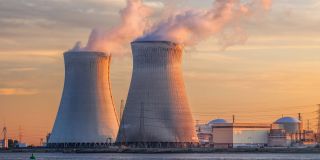Unit 3 of the Vogtle plant under construction (Photo: Georgia Power)
To reach President Biden’s goal of cutting U.S. carbon emissions in half by 2030 and to have a net-zero carbon economy by 2050, some environmentalists are reconsidering their opposition to nuclear energy’s role as a climate crisis solution. According to the article, The controversial future of nuclear power in the U.S., from National Geographic, nuclear power has a lot going for it. Its carbon footprint is equivalent to wind, less than solar, and orders of magnitude less than coal. Nuclear power plants take up far less space on the landscape than solar or wind farms, and they produce power even at night or on calm days.
The above figure provides NYISO's projected mix of resource capacity expected to be available for the 2021 Summer Capability Period.
The figure below shows the vast difference in 2020 between clean energy provided to upstate New York and to downstate New York. With the recent closure of Indian Point-3, the difference will widen for downstate New York in 2021.
NYISO released its 2021 power trends report for the state of New York. As noted by many in the energy community prior to the closure of Indian Point nuclear power plant's Unit 2 and Unit 3 in 2020 and 2021, respectively, the projected mix of resource capacity expected for downstate New York's energy generation will be heavily reliant on fossil fuels.
Vogtle-3 turbine generator. Photo: Georgia Power
Southern Company is targeting December for placing Vogtle-3 in service, according to Tom Fanning, the company’s chairman, president, and chief executive officer, who spoke with financial analysts on April 29 in its first-quarter earnings call. “The site work plan now targets fuel load in the third quarter and late December 2021 in-service date for Unit 3,” Fanning said. “Of course, any delays could result in a first-quarter 2022 Unit 3 in-service date.”
Author Joshua Goldstein, from the video "The Nuclear Option"
Climate activists rarely mention nuclear power as a tool in the battle against climate change, consumer reporter John Stossel comments during the video "The Nuclear Option" on his YouTube channel.
NorthStar is capable of producing Mo-99 using non-uranium-based processes. Photo: NorthStar Medical Radioisotopes
Completing a 5,700-mile journey from Belgium, two 24-ton particle accelerators were delivered to NorthStar Medical Radioisotopes’ facility in Beloit, Wis., on April 22, the Wisconsin State Journal reported. Photos and a video of the accelerators being received at the facility are included in the report.
The New Safe Confinement in final position over reactor 4 at the Chernobyl nuclear power plant in 2017. Photo: Tim Porter
On April 26, 1986, reactor No. 4 of the Chernobyl nuclear power plant in Ukraine exploded, sending radioactive material into the environment and across Europe. After 35 years, Ukrainians are looking to the site of the world’s worst nuclear disaster “for inspiration, solace, and income,” according to an ABC News report.
Diver John Lehto (right) receives final instructions from Carter Thomas before entering a 300,000-gallon water tank at the Hanford Site. Lehto and Thomas are employees of Hanford Site subcontractor Associated Underwater Services. Photos: DOE EM
The Department of Energy’s Richland Operations Office contractors Central Plateau Cleanup Company (CPCCo) and Hanford Mission Integration Solutions (HMIS) teamed up recently to dive into inspection and maintenance activities at the Hanford Site in Washington state.
Project video: View this video for sights and sounds from this unique project.
Lise Meitner and Otto Hahn in their lab in Germany in 1913.
Comparing matter to a “lush tapestry, woven from a complex assortment of threads,” physics writer Emily Conover traces the evolution of our understanding of the atom over the past century in the recent Science News article, “How matter’s hidden complexity unleashed the power of nuclear physics.” Conover uncovers how our vision of matter changed from that of a “no-nonsense plaid” to one of an “ornate brocade,” ultimately transforming nuclear physics from an arcane academic pursuit to something that forever changed the world.
The Indian Point nuclear power plant
With a blunt but indisputably accurate headline, an article from yesterday’s New York Times on the imminent closure of Indian Point makes it immediately clear what will happen when Unit 3, the nuclear plant’s last operating reactor, is shut down at the end of this month: The state of New York will be forced to rely more heavily on fossil fuels for electricity generation.
Following the retirement of Indian Point-2 last April, the share of New York’s power coming from gas-fired plants rose to about 40 percent, from about 36 percent in 2019, the piece notes, adding that the share from renewables moved up only slightly, to about 30 percent.
In this illustration of the effects of two neutron yields (50 kt and 1 Mt) and two neutron energies (14.1 MeV and 1 MeV), the black dots represent the location of a nuclear device. Dark blue indicates where the asteroid remains solid, while all other colors show where material has been melted or vaporized. The illustration depicts asteroids with 0.8-m and 5-m diameters—much smaller than the 300-m asteroid simulated in the study—to enhance the visibility of the area of the energy deposition. Image: LLNL
A research collaboration between Lawrence Livermore National Laboratory and the Air Force Institute of Technology (AFIT) has investigated how the neutron energy generated by the detonation of a nuclear device could affect the path and speed of an asteroid on a collision course with Earth by melting and vaporizing a portion of the asteroid. The research, which compared the deflection caused by two different neutron energies—14.1 MeV and 1 MeV, representing fusion and fission neutrons, respectively—is described in an article published by LLNL on April 8.


















 New research indicates
New research indicates